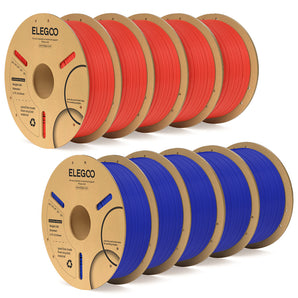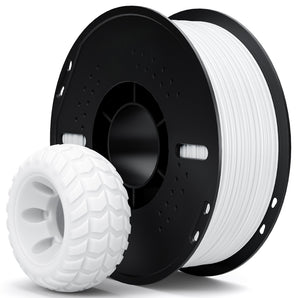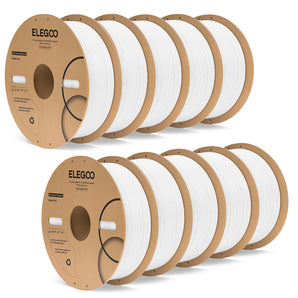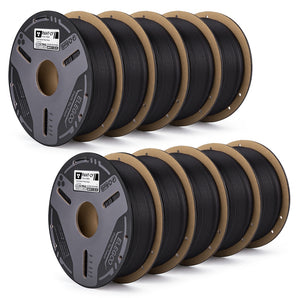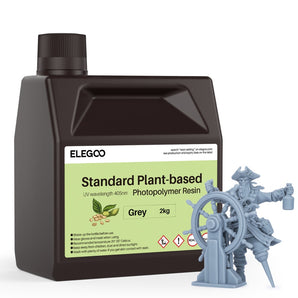Eco-Friendly 3D Printing Insights
In the realm of 3D printing, the quest for sustainability and eco-friendliness is reshaping the industry. This article explores the intersection of 3D printing and environmental consciousness, focusing on sustainable 3D printing filaments and practices.
Whether you are a seasoned 3D resin printer user, a beginner, or someone passionate about the environment, understanding the environmental impact and sustainable alternatives in 3D printing is crucial.
This article is a gateway to understanding how 3D printing can align with ecological responsibility and contribute to a sustainable future.
Article Outline
- Why is Sustainability Crucial in 3D Printing?
- What are the Eco-friendly 3D Printing Materials Available?
- What’s Special About Elegoo Plant-Based Resin?
- How is 3D Printing Helping in Reducing Plastic Waste?
- Are Biodegradable 3D Printing Filaments the Sustainable Future?
- How are Startups Innovating in Sustainable 3D Printing?
- Can 3D Printing Enhance Sustainability in Traditional Manufacturing?
- What Role Does Recycling Play in 3D Printing?
- Is Sustainable 3D Printing Economically Viable?
- How is 3D Printing Contributing to Sustainable Urban Development?
- What are the Challenges and Solutions in Sustainable 3D Printing?
Why is Sustainability Crucial in 3D Printing?
Sustainability in 3D printing is pivotal as it addresses the environmental impact associated with the materials used and the printing process.
The majority of 3D printing relies on plastic filaments, which, if not managed properly, can contribute to environmental degradation.
Embracing sustainable and eco-friendly 3D printing practices is essential in mitigating adverse environmental effects and promoting responsible consumption and production in the 3D printing sector.
What are the Eco-friendly 3D Printing Materials Available?
Eco-friendly 3D printing materials are paramount in advancing sustainable 3D printing. Materials like PLA (Polylactic Acid), a biodegradable 3D printing filament made from plant-based resources, are leading the way.
These environmentally friendly materials decompose naturally, minimizing environmental harm and offering a green alternative to petroleum-based plastics. The adoption of such eco-friendly 3D printing materials is a significant stride towards achieving sustainability in 3D printing.
What's Special About Elegoo Plant-Based Resin?
The Elegoo Plant-Based Resin, predominantly derived from soybean, ensures BPA-free properties, minimal odor, and almost non-existent pungent fumes. Additionally, we introduce the Elegoo PLA filaments, a testament to our commitment to environmental sustainability, as PLA is a biodegradable material.
We have resources dedicated to our Plant-Based Resins and our PLA Filaments.
How is 3D Printing Helping in Reducing Plastic Waste?
3D printing is instrumental in reducing plastic waste by utilizing recycled filaments. Several initiatives and companies are converting plastic waste into 3D printing material, thus contributing to waste reduction and promoting the circular economy.
By transforming waste into valuable and functional 3D printed products, the 3D printing industry is playing a vital role in addressing the global issue of plastic waste and promoting sustainable practices.
Are Biodegradable 3D Printing Filaments the Sustainable Future?
Biodegradable 3D printing filaments represent a sustainable future in 3D printing. Materials like PLA are gaining popularity due to their environmentally friendly properties, decomposing naturally without leaving harmful residues.
The growing emphasis on biodegradable filaments indicates a shift towards environmental consciousness within the 3D printing community.
The continuous development and adoption of such materials are crucial for minimizing the ecological footprint of 3D printing.
How are Startups Innovating in Sustainable 3D Printing?
Startups are pioneering innovations in sustainable 3D printing by developing new materials and optimizing printing processes.
These startups are focusing on creating sustainable 3D printing materials, reducing waste, and exploring applications of 3D printing in sustainable manufacturing.
The innovations driven by startups are pushing the boundaries and setting new standards in eco-friendly 3D printing, fostering advancements in sustainable additive manufacturing.
Can 3D Printing Enhance Sustainability in Traditional Manufacturing?
3D printing offers a sustainable alternative to traditional manufacturing methods by reducing material waste and energy consumption.
Unlike subtractive manufacturing, 3D printing builds objects layer by layer, using only the material needed, thus minimizing waste. The ability to produce lightweight and optimized designs through 3D printing also contributes to material and energy savings, making it a sustainable option in manufacturing processes.
What Role Does Recycling Play in 3D Printing?
Recycling is integral to sustainable 3D printing. Utilizing recycled materials in 3D printing conserves natural resources and reduces waste.
Many companies are developing recycled filaments from plastic waste, transforming discarded plastics into valuable 3D printing materials.
The focus on recycling in 3D printing underscores the industry’s commitment to sustainability and its potential to contribute to a circular and eco-friendly economy.
Is Sustainable 3D Printing Economically Viable?
Sustainable 3D printing is not only environmentally beneficial but also economically viable. Using recycled and eco-friendly materials can lower costs related to raw material acquisition and waste management.
Additionally, the optimized designs achievable through 3D printing can lead to material and energy savings, further reducing overall costs.
The economic viability of sustainable 3D printing can encourage its adoption across various sectors, leading to more responsible and sustainable practices.
How is 3D Printing Contributing to Sustainable Urban Development?
3D printing is making significant contributions to sustainable urban development by providing innovative solutions in construction and urban planning.
The technology enables the creation of sustainable building materials and efficient construction methods, reducing environmental impact.
Projects like “Print Your City” demonstrate how 3D printing can transform plastic waste into functional urban infrastructure, contributing to sustainable urban environments and promoting circular economy principles in city development.
What are the Challenges and Solutions in Sustainable 3D Printing?
Sustainable 3D printing faces challenges such as the availability and cost of sustainable materials and the energy consumption of 3D printers.
Addressing these challenges requires ongoing research, industry collaboration, and increased awareness. Developing new eco-friendly materials, improving the energy efficiency of 3D printers, and promoting sustainable practices are essential solutions to overcome the challenges and realize the full potential of sustainable 3D printing.
In Conclusion:
- Sustainability is crucial in 3D printing to mitigate its environmental impact.
- Eco-friendly 3D printing materials like PLA are leading the way towards a sustainable future in 3D printing.
- 3D printing is instrumental in reducing plastic waste by utilizing recycled filaments.
- Biodegradable 3D printing filaments represent the sustainable future of 3D printing.
- Startups are innovating in sustainable 3D printing by developing new materials and optimizing printing processes.
- 3D printing enhances sustainability in traditional manufacturing by reducing material waste and energy consumption.
- Recycling plays a pivotal role in promoting sustainability in 3D printing.
- Sustainable 3D printing is economically viable, encouraging its widespread adoption.
- 3D printing contributes to sustainable urban development by providing innovative solutions in construction and urban planning.
- Addressing the challenges in sustainable 3D printing requires ongoing research, industry collaboration, and increased awareness.


























































